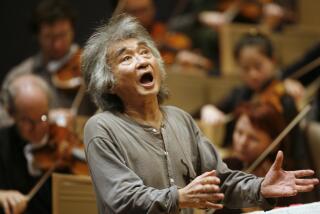Harth-Bedoya makes the night dance at the Hollywood Bowl
Miguel Harth-Bedoya led the Los Angeles Philharmonic in a likable and satisfying performance of Tchaikovsky’s Fourth Symphony at the Hollywood Bowl on Tuesday night. What made it likable was the rhythmic lilt. But what made it satisfying was more important. Fate, for once, was no big deal.
Tchaikovsky’s turbulent tale has been often told. He began the symphony in 1876 shortly after meeting a generous patron, Nadezhda von Meck, a widow who supported him and served as a confidante. The composer, who was closeted in homophobic Russia, finished the score the following year, having just endured a brief and disastrous marriage to another woman. The emotional roller coaster left him practically psychotic.
The composer’s way out of madness, he wrote to Von Meck, was to portray fate as an F-minor brass fanfare that rises from the depths and influences the symphonic development for 40 minutes. The work isn’t so much an engineered musical argument as a free-flowing representation of a melancholy journey, with elusive hope always around the next corner.
But Harth-Bedoya does not have a gloomy Russian soul. Rather, the Peruvian conductor, as composer Osvaldo Golijov once said, naturally balances earth, air, fire and water. He never looks troubled on the podium. He has a square jaw, a winning smile and a broad stick technique. He doesn’t appear to mold phrases and finesse details so much as to open the tap and let the music pour out.
Rapid success was predicted for Harth-Bedoya when he served as the Los Angeles Philharmonic’s associate conductor. So quickly did the orchestra take to him that eight months after he was hired as an assistant to Esa-Pekka Salonen in 1998, he was promoted to associate conductor, a post he held until 2004. Eight years ago, he also became music director of the Fort Worth Symphony, which seemed at the time a good steppingstone.
Today he’s still in Fort Worth, but he has had time to mature. Some Texas observers credit him with making a third-tier ensemble more exciting than the celebrated nearby Dallas Symphony. And, increasingly, he is seen conducting A-list American orchestras.
Bowl audiences like lightweight fare such as Saint-Saëns’ First Cello Concerto, which was on the first half of the program. But Harth-Bedoya did get away with opening with excerpts from Alberto Ginastera’s “Estancia,” a ballet the Argentine composer wrote in 1941 in a style sometimes likened to Copland’s. The rhythmically lithe sense of dance that Harth-Bedoya achieved was irresistible.
Daniel Müller-Schott was the cello soloist in Saint-Saëns’ concerto. One could make a historical case for programming it. The work was premiered four years before Tchaikovsky began his symphony, and the composers were friends. They are said to have once performed a drag ballet together at a party in Russia.
The concerto is best if it seems to float on air. I last encountered Müller-Schott as an intense, emerging cellist who played chamber music with violinist Anne-Sophie Mutter. He’s now starting to make a career as a soloist, but -- with his fast, nervous vibrato -- he lacks the Gallic charm necessary for Saint-Saëns. Worse, an opportunity was lost. Earlier this year at Carnegie Hall, Harth-Bedoya conducted the premiere of Golijov’s “Mariel,” a beguiling work for cello and orchestra that would have suited this occasion far better.
Tchaikovsky’s Fourth, at least, ended the evening as it had begun, with a strong feeling of dance. Harth-Bedoya kept Tchaikovsky’s long, undulating melodic lines in gratifying motion.
Melody means much in Tchaikovsky and particularly so in the sorrowful Andante. The oboe is this movement’s star, and the Philharmonic’s young principal, Ariana Ghez, played her sinuous opening line with touching raw emotion.
More to Read
The biggest entertainment stories
Get our big stories about Hollywood, film, television, music, arts, culture and more right in your inbox as soon as they publish.
You may occasionally receive promotional content from the Los Angeles Times.







